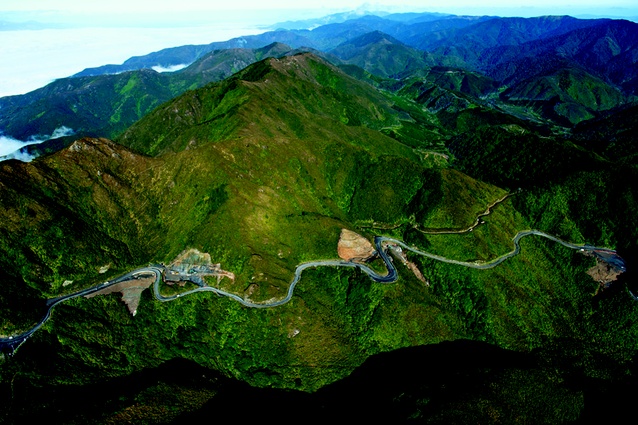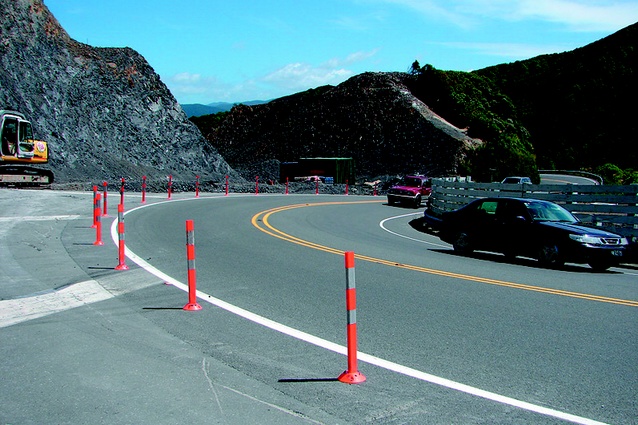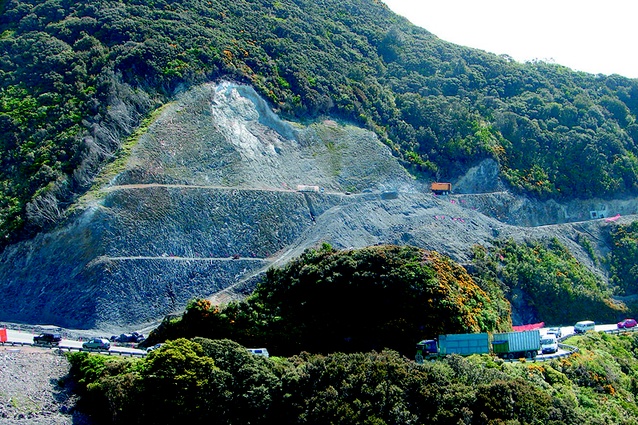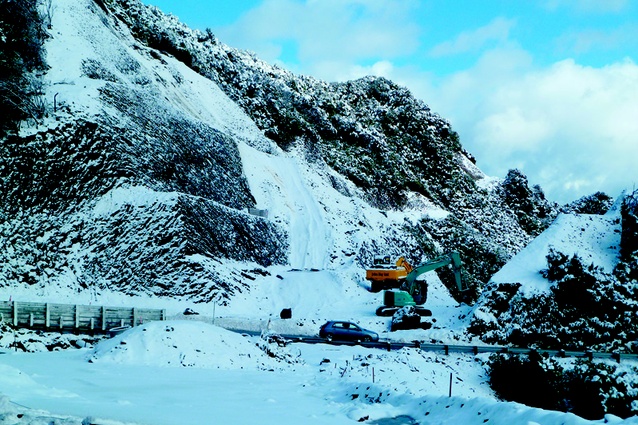Fixing the notorious Muldoon Corner
Muldoon’s Corner Easing Project began in August 2009. The corner, one story goes, was named after a budget of that prime minister, said to be “tight and to the right”. The upgrade and realignment of one kilometre of road near the summit on the Wellington side will ease two particularly tight corners, widen the road and improve motorist safety, speed and possibly fuel bills. The $16.5 million project will widen this part of the road to 10 metres, with lane widths of 3.5 metres and to a design speed of 55 km/h.
From an economics’ point of view the project (funded under the government’s economic stimulus package) is providing jobs and easing access for tourism, heavy haulage and daily commuters.
The steep terrain is 500 metres above sea level. This slope, along with extreme weather conditions at times, throws some challenges at NZTA and the consultants, Opus International and contractors, Hawkins Infrastructure. Snow closed the Rimutaka Hill twice last year. There has been heavy rainfall, and wind and sun on the exposed site can reach blistering temperatures. Hawkins’ weather station has recorded winds up to 160 km/h and drilling crews working on the top benches are harnessed.
Key parties, which include regional councils, iwi, road user representatives and emergency services, are working closely under a partnership charter. Keith Atkinson, principal projects engineer at Opus, says apart from the location and climate it is a relatively straightforward earthworks project. Approximately 80 per cent of the rock is R2-type grey wacke, the harder of the two rock classifications, however, they haven’t had to blast any of it so far. The terrain is extremely variable. Faulting goes in many different directions, requiring extra stabilisation measures, such as rock anchors.
“It’s only as good as the weakest material,” Atkinson says. “In some cases you may have reasonably strong rock but there are old faults and so on that are the weakest points so the material is only as good as that. We find out where they are but you can never be 100 per cent sure you’ve found all the weak spots.” Investigations for the whole route span several years. “It’s a matter of picking off the ones that are more critical. On a couple of those tight corners large vehicles can’t safely pass each other. They have actually been wedged to together on occasion.”
The project, currently moving into stage two, is what Hawkins’ project manager, Ben Lawlor, calls “vertically challenging”. To the ordinary traveller challenging may seem an understatement. Huge bluffs stand cut and raw, rock and clay exposed. Bends and gullies opposite are banked up with the cut material. During stage one, major earthworks brought down the bluffs and transferred them into fill sites. The contractors brought the fill up to the bends with controlled buttressing, which will support the realigned road. Lawlor says cuts are in the order of 60 metres high and fill sites around 80 metres. The fill sites are a combination of engineer designed, reinforced earth fill.
“We are rolling and compacting material. In between the layers we are putting high tensile Tensar geogrids. It’s like a 80- or 50-metre-high controlled wedge.”The geogrid mesh is basically a wire mesh coated in plastic. It acts like the reinforcing mesh in a concrete slab, and allows them to build the fills steeper than 1:1 - something they have to do to match the existing terrain.
Getting access to the hillside construction sites high above the road was the job of the biggest excavators they could use for the conditions. They have 30, 20 and 6-tonne excavators for the cutting work (50 in total) and, specially required for this site, tracked dumpers to bring material down.
Hawkins will use abseilers to do a series of rock anchors to hold the front face of the rock section where access is difficult or unable to be created. The drills, capable of drilling 6 metre long holes, will also be abseiled. A crane will lift the men and equipment to the top of the hill where they will anchor abseiling points. Mesh in between the anchors will control any stability issues.
Another challenge is to get the staging right with as little disruption as possible. The new and old roads overlap along parts of the project, but at height differences of up to six metres, it creates a logistical problem since the road must remain open to at least one lane at all times, Cribb says. With the height difference, ramps making the transition from new to old can’t be too steep so as to allow trucks passageway.
The contractors stay off the road at peak times and ensure priority goes to uphill traffic. Five minutes is the maximum wait time allowed.














